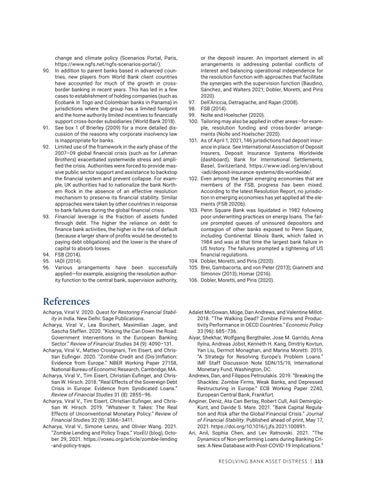90.
91. 92.
93.
94. 95. 96.
change and climate policy (Scenarios Portal, Paris, https://www.ngfs.net/ngfs-scenarios-portal/). In addition to parent banks based in advanced countries, new players from World Bank client countries have accounted for much of the growth in crossborder banking in recent years. This has led in a few cases to establishment of holding companies (such as Ecobank in Togo and Colombian banks in Panama) in jurisdictions where the group has a limited footprint and the home authority limited incentives to financially support cross-border subsidiaries (World Bank 2018). See box 1 of Brierley (2009) for a more detailed discussion of the reasons why corporate insolvency law is inappropriate for banks. Limited use of the framework in the early phase of the 2007–09 global financial crisis (such as for Lehman Brothers) exacerbated systemwide stress and amplified the crisis. Authorities were forced to provide massive public sector support and assistance to backstop the financial system and prevent collapse. For example, UK authorities had to nationalize the bank Northern Rock in the absence of an effective resolution mechanism to preserve its financial stability. Similar approaches were taken by other countries in response to bank failures during the global financial crisis. Financial leverage is the fraction of assets funded through debt. The higher the reliance on debt to finance bank activities, the higher is the risk of default (because a larger share of profits would be devoted to paying debt obligations) and the lower is the share of capital to absorb losses. FSB (2014). IADI (2014). Various arrangements have been successfully applied—for example, assigning the resolution authority function to the central bank, supervision authority,
97. 98. 99. 100. 101.
102.
103.
104. 105. 106.
or the deposit insurer. An important element in all arrangements is addressing potential conflicts of interest and balancing operational independence for the resolution function with approaches that facilitate the synergies with the supervision function (Baudino, Sánchez, and Walters 2021; Dobler, Moretti, and Piris 2020). Dell’Ariccia, Detragiache, and Rajan (2008). FSB (2014). Nolte and Hoelscher (2020). Tailoring may also be applied in other areas—for example, resolution funding and cross-border arrangements (Nolte and Hoelscher 2020). As of April 1, 2021, 146 jurisdictions had deposit insurance in place. See International Association of Deposit Insurers, Deposit Insurance Systems Worldwide (dashboard), Bank for International Settlements, Basel, Switzerland, https://www.iadi.org/en/about -iadi/deposit-insurance-systems/dis-worldwide/. Even among the larger emerging economies that are members of the FSB, progress has been mixed. According to the latest Resolution Report, no jurisdiction in emerging economies has yet applied all the elements (FSB 2020b). Penn Square Bank was liquidated in 1982 following poor underwriting practices on energy loans. The failure prompted queues of uninsured depositors and contagion of other banks exposed to Penn Square, including Continental Illinois Bank, which failed in 1984 and was at that time the largest bank failure in US history. The failures prompted a tightening of US financial regulations. Dobler, Moretti, and Piris (2020). Brei, Gambacorta, and von Peter (2013); Giannetti and Simonov (2013); Homar (2016). Dobler, Moretti, and Piris (2020).
References Acharya, Viral V. 2020. Quest for Restoring Financial Stability in India. New Delhi: Sage Publications. Acharya, Viral V., Lea Borchert, Maximilian Jager, and Sascha Steffen. 2020. “Kicking the Can Down the Road: Government Interventions in the European Banking Sector.” Review of Financial Studies 34 (9): 4090–131. Acharya, Viral V., Matteo Crosignani, Tim Eisert, and Christian Eufinger. 2020. “Zombie Credit and (Dis-)Inflation: Evidence from Europe.” NBER Working Paper 27158, National Bureau of Economic Research, Cambridge, MA. Acharya, Viral V., Tim Eisert, Christian Eufinger, and Christian W. Hirsch. 2018. “Real Effects of the Sovereign Debt Crisis in Europe: Evidence from Syndicated Loans.” Review of Financial Studies 31 (8): 2855–96. Acharya, Viral V., Tim Eisert, Christian Eufinger, and Christian W. Hirsch. 2019. “Whatever It Takes: The Real Effects of Unconventional Monetary Policy.” Review of Financial Studies 32 (9): 3366–3411. Acharya, Viral V., Simone Lenzu, and Olivier Wang. 2021. “Zombie Lending and Policy Traps.” VoxEU (blog), October 29, 2021. https://voxeu.org/article/zombie-lending -and-policy-traps.
Adalet McGowan, Müge, Dan Andrews, and Valentine Millot. 2018. “The Walking Dead? Zombie Firms and Productivity Performance in OECD Countries.” Economic Policy 33 (96): 685–736. Aiyar, Shekhar, Wolfgang Bergthaler, Jose M. Garrido, Anna Ilyina, Andreas Jobst, Kenneth H. Kang, Dmitriy Kovtun, Yan Liu, Dermot Monaghan, and Marina Moretti. 2015. “A Strategy for Resolving Europe’s Problem Loans.” IMF Staff Discussion Note SDN/15/19, International Monetary Fund, Washington, DC. Andrews, Dan, and Filippos Petroulakis. 2019. “Breaking the Shackles: Zombie Firms, Weak Banks, and Depressed Restructuring in Europe.” ECB Working Paper 2240, European Central Bank, Frankfurt. Anginer, Deniz, Ata Can Bertay, Robert Cull, Asli DemirgüçKunt, and Davide S. Mare. 2021. “Bank Capital Regulation and Risk after the Global Financial Crisis.” Journal of Financial Stability. Published ahead of print, May 17, 2021. https://doi.org/10.1016/j.jfs.2021.100891. Ari, Anil, Sophia Chen, and Lev Ratnovski. 2021. “The Dynamics of Non-performing Loans during Banking Crises: A New Database with Post-COVID-19 Implications.” RESOLVING BANK ASSE T DISTRESS | 113

